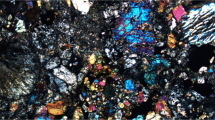Abstract
This text summarize topics of the contributions included in the Rock-Slope Instability and Failure chapter.
You have full access to this open access chapter, Download conference paper PDF
Similar content being viewed by others
Keywords
This session includes contributions on fundamental mechanisms related to the formation of rock-slope instability, as well as new methods developed for hazard analysis and risk mitigation, at many spatial and temporal scales. As discussed in contributions to this session, investigations of larger-volume rock-slope instabilities are based on the study of preconditioning through rock faulting and jointing, erosion, retrogressive slope failure, stress transfer, groundwater flow and chemical weathering. Fundamental research topics related to long-term slope displacement include cyclic loading from seismic, hydraulic and thermal forces causing fatigue and progressive damage as preparatory factors leading to slope failure. Even though the mechanisms causing accelerating rock-slope deformation prior to failure are not fully understood, detailed displacement monitoring over time, when correlated with critical environmental factors, provide a reliable early warning indicator. All these components are integrated in new best practices developed for identification and classification of regional large-volume rock slope hazards and risks.
The post-failure behavior of smaller-volume rock slope failures is often assessed through dynamic rockfall modeling delivering the spatial distribution and intensity of rock block movements. As discussed in this session, the design of counter measures for such rock slope failures requires an understanding of structure and deformation in the release area as well as friction, mobility and ground interactions of the released rock masses in the transit and deposition areas. The design of effective rock-fall barriers is based on detailed case-history analyses, large-barrier performance tests, and sophisticated mathematical models. The rockfall-fence design and implementation should follow standard codes of practice, which are also illustrated in contributions to this session.
Author information
Authors and Affiliations
Corresponding author
Editor information
Editors and Affiliations
Rights and permissions
Copyright information
© 2014 Springer International Publishing Switzerland
About this paper
Cite this paper
Loew, S., Klimeš, J. (2014).
 Introduction: Rock-Slope Instability and Failure.
In: Sassa, K., Canuti, P., Yin, Y. (eds) Landslide Science for a Safer Geoenvironment. Springer, Cham. https://doi.org/10.1007/978-3-319-04996-0_12
Introduction: Rock-Slope Instability and Failure.
In: Sassa, K., Canuti, P., Yin, Y. (eds) Landslide Science for a Safer Geoenvironment. Springer, Cham. https://doi.org/10.1007/978-3-319-04996-0_12
Download citation
DOI: https://doi.org/10.1007/978-3-319-04996-0_12
Published:
Publisher Name: Springer, Cham
Print ISBN: 978-3-319-04995-3
Online ISBN: 978-3-319-04996-0
eBook Packages: Earth and Environmental ScienceEarth and Environmental Science (R0)




